My wife and I lived in Boston for a long time before relocating to Florida. Our daughter was born there. In what has become something of a family tradition, we made plans to drive to Tampa to see the Boston Red Sox play the Tampa Bay Rays (formerly known as the Tampa Bay Devil Rays, but fundamentalist Christian groups found that name objectionable). We usually find these games enjoyable, due to the huge number of Red Sox fans who attend. Typically, the perennial first-place Red Sox kick the tar out of the perennial last-place Rays, which compensates us to some degree for the 4-hour round-trip drive.
But someone told us that the Tampa Bay ownership had decided, in their infinite wisdom, to host something called Cowbell Night. Every Tampa Bay fan wearing a Rays hat, t-shirt or team jersey would be given a cowbell at the door. We stopped off before the game and picked up some foam earplugs.
During the game, Tampa Bay fans created a hideous din, forcing me to use the earplugs. To make matters worse, Boston lost the game, their fourth loss in a row. Their best slugger went hitless all night, one player made a stupid base-running error, and they left the starting pitcher in for the whole game, despite clear evidence that he was tiring. It was depressing, but the depression was made physically painful by the constant clatter of those damn cowbells.
When I was living in Boston back in the 70’s and 80’s, my friends and I used to make fun of losing teams like Cleveland who played in an enormous stadium that was only filled to a fraction of its capacity by depressed fans. A home run would rattle around in empty bleacher seats. Tropicana field, where the Rays play, is a big, three-tier domed stadium, but when the Red Sox play, it’s filled nearly to capacity. A foul ball or home run drops into a sea of fans from both teams, eager to go home with a game ball.
I have to wonder how many Red Sox fans will show up next year, after suffering through Cowbell Night. I also have to wonder how many Tampa Bay fans found the noise as unpleasant as I did. Maybe ticket sales will decline next season as a direct result of Cowbell Night, and I can look forward to watching the games on TV, laughing at the home run balls bouncing around in empty seats.
Sunday, April 27, 2008
Tuesday, April 22, 2008
This Book Stinks
About 20 years ago, I left my house and went out to a florist shop. Upon entering the shop, I was confronted by a pungent, unpleasant odor, rather than the sweet fragrance one usually associates with flowers. A very gay man came out from the back room, and I asked him about the smell. “It’s chocolate raspberry coffee!” he declared, “Doesn’t it smell WONDERUL?” No, it did not smell wonderful. It smelled repulsive, a thick and alien perversion of coffee.
When I had concluded my business, I got into my car, and noticed that the cloying odor had followed me there, gagging me all the way back to the house. I couldn’t shake it all day, tormented by hints and whiffs, as though it was hiding in my clothing.
That evening, my wife came home with some groceries and busied herself in the kitchen. Within minutes, I was assaulted by the horrid smell again, and rushed downstairs to find my wife making a pot of chocolate raspberry coffee. “Doesn’t this smell GREAT?” she asked.
For a couple of weeks after I dumped the coffee down the drain, I kept experiencing that weird sensory déjà vu, as little wafts of the disgusting odor seemed to emerge from nowhere. Showers didn’t help. Air freshener didn’t help. It was awful. I developed a theory that some odors are composed of molecules that are so large and complex that they cannot be absorbed or metabolized by the body. Instead, they lodge in the sinuses, continuously triggering the scent receptors for weeks or months.
Recently, I ordered a book from Amazon. Normally, when I place such an order, I order a used book, because they’re so much cheaper. The book arrived yesterday, and it smells.
It smells really, really bad. It has a copyright date of 1989, and it smells like it was kept as reading material in a communal outhouse on a Turkish garlic farm for all that time. Worse, the odor is staying with me. I can smell it in the car, I can smell it at work. I worry that other people can smell it on me.
What’s even worse than that is that I’m enjoying the novel. It’s like watching your favorite comedy on TV in the hospital while you recover from hernia surgery. You want to laugh, but you can’t. I’m wondering how much more I would enjoy the book it if it didn’t smell so badly.
When I had concluded my business, I got into my car, and noticed that the cloying odor had followed me there, gagging me all the way back to the house. I couldn’t shake it all day, tormented by hints and whiffs, as though it was hiding in my clothing.
That evening, my wife came home with some groceries and busied herself in the kitchen. Within minutes, I was assaulted by the horrid smell again, and rushed downstairs to find my wife making a pot of chocolate raspberry coffee. “Doesn’t this smell GREAT?” she asked.
For a couple of weeks after I dumped the coffee down the drain, I kept experiencing that weird sensory déjà vu, as little wafts of the disgusting odor seemed to emerge from nowhere. Showers didn’t help. Air freshener didn’t help. It was awful. I developed a theory that some odors are composed of molecules that are so large and complex that they cannot be absorbed or metabolized by the body. Instead, they lodge in the sinuses, continuously triggering the scent receptors for weeks or months.
Recently, I ordered a book from Amazon. Normally, when I place such an order, I order a used book, because they’re so much cheaper. The book arrived yesterday, and it smells.
It smells really, really bad. It has a copyright date of 1989, and it smells like it was kept as reading material in a communal outhouse on a Turkish garlic farm for all that time. Worse, the odor is staying with me. I can smell it in the car, I can smell it at work. I worry that other people can smell it on me.
What’s even worse than that is that I’m enjoying the novel. It’s like watching your favorite comedy on TV in the hospital while you recover from hernia surgery. You want to laugh, but you can’t. I’m wondering how much more I would enjoy the book it if it didn’t smell so badly.
Tuesday, April 15, 2008
Finally, Kitchen Pictures
OK, enough time has elapsed that I think I can finally show you the finished kitchen. After our shopping trip to IKEA, we took delivery on this huge pile of cabinet parts and hardware:
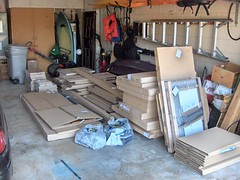
Each item is flat-packed, so I had to assemble them, one by one. Here’s the first one:
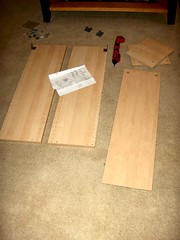
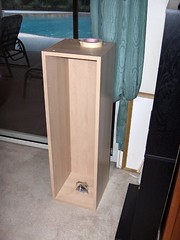
By the time I finished, the living room and dining room were full of them:
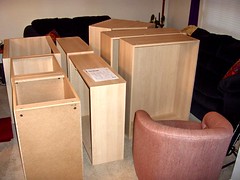
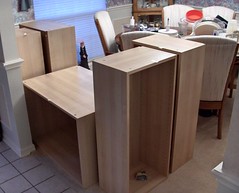
We hired a couple of guys to tear everything out, and they did:

Then, they put in new electrical service, installed the new ceramic floor tile and put up new sheetrock:

When they started putting in the cabinets, it didn’t go very well. The workmen had done a lot of kitchens, but they had never installed IKEA cabinets before. By the time it was over, they had a pretty low opinion of them from an installation perspective. I won’t go into the messy details, but I agree it would have gone a lot smoother if we had ordered custom cabinets.

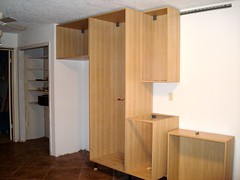
After the cabinets were installed, we ordered the Corian countertops. Since they were going to take a few weeks to fabricate, I spent that time assembling doors and drawers and attaching handles to everything.
The main counter is “L” shaped, and I assumed it would be delivered in one piece. Instead, it came in two pieces. Here’s the first piece installed:
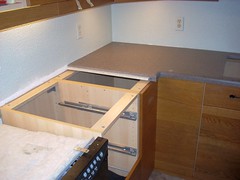
When they added the second piece, there was a visible seam with a big “lump” on the rounded edge (you can see the lump on the right side of this picture):
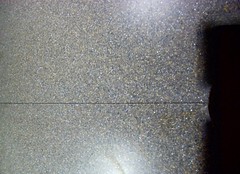
The installers brought out these awesome cool vacuum clamps and attached them straddling the seam. When they switched on a pump, the clamps sucked down tight on the countertops. They applied a colored adhesive in the seam, and then tightened the two sections of the countertop together with the clamps and let it dry:
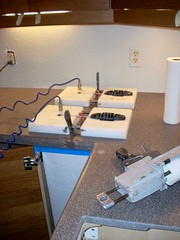
After removing the clamps, one of the installers ground off the "lump" and sanded the seam with fine grit sandpaper, and now I can’t find the seam even though I know exactly where it is.
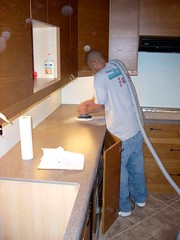
Lots of people are putting in granite countertops these days, but granite will always have a seam. That’s why we picked Corian.
So here are some shots of the finished kitchen. On one side is the sink, microwave and dishwasher. Against the back wall is one of those glass cooktops.

On the other side, we have a built-in oven and much more cabinet space than we did before. Plus, we bought 39-inch high wall cabinets, so they go all the way to the ceiling. This means we had to buy a step-stool for my petite wife.

The last bit is this little desk setup, which we created by putting cabinets on either side of a kneehole area and installing a Corian countertop across the top. You’ll notice a little shelf above the desk, which is not part of the IKEA catalog of cabinet options. I take credit for crafting it out of some spare parts:
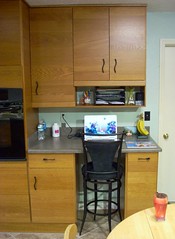
And that’s it! Thanks for bearing with me. I hope I don’t get into too much trouble for showing it to you.

Each item is flat-packed, so I had to assemble them, one by one. Here’s the first one:


By the time I finished, the living room and dining room were full of them:


We hired a couple of guys to tear everything out, and they did:

Then, they put in new electrical service, installed the new ceramic floor tile and put up new sheetrock:

When they started putting in the cabinets, it didn’t go very well. The workmen had done a lot of kitchens, but they had never installed IKEA cabinets before. By the time it was over, they had a pretty low opinion of them from an installation perspective. I won’t go into the messy details, but I agree it would have gone a lot smoother if we had ordered custom cabinets.


After the cabinets were installed, we ordered the Corian countertops. Since they were going to take a few weeks to fabricate, I spent that time assembling doors and drawers and attaching handles to everything.
The main counter is “L” shaped, and I assumed it would be delivered in one piece. Instead, it came in two pieces. Here’s the first piece installed:

When they added the second piece, there was a visible seam with a big “lump” on the rounded edge (you can see the lump on the right side of this picture):

The installers brought out these awesome cool vacuum clamps and attached them straddling the seam. When they switched on a pump, the clamps sucked down tight on the countertops. They applied a colored adhesive in the seam, and then tightened the two sections of the countertop together with the clamps and let it dry:

After removing the clamps, one of the installers ground off the "lump" and sanded the seam with fine grit sandpaper, and now I can’t find the seam even though I know exactly where it is.

Lots of people are putting in granite countertops these days, but granite will always have a seam. That’s why we picked Corian.
So here are some shots of the finished kitchen. On one side is the sink, microwave and dishwasher. Against the back wall is one of those glass cooktops.

On the other side, we have a built-in oven and much more cabinet space than we did before. Plus, we bought 39-inch high wall cabinets, so they go all the way to the ceiling. This means we had to buy a step-stool for my petite wife.

The last bit is this little desk setup, which we created by putting cabinets on either side of a kneehole area and installing a Corian countertop across the top. You’ll notice a little shelf above the desk, which is not part of the IKEA catalog of cabinet options. I take credit for crafting it out of some spare parts:

And that’s it! Thanks for bearing with me. I hope I don’t get into too much trouble for showing it to you.
Sunday, April 13, 2008
There's a Phone in my Phone?
Recently, I watched an interesting, passionate speech by science-fiction author Bruce Sterling, on the subject of user interface design as it relates to networked devices. One point he made had to do with the convergence of devices. He used the cell phone as an example, which has (in his words) “replaced” so many other common discrete devices, such as the digital camera and the calculator.
I disagree with him on this point, because while it’s true that those functions do exist in a cell phone, they have been added more as sales bling than as actual replacement devices. It’s like the convenience store and the supermarket. You only use the convenience store when circumstances make it worthwhile to forgo the better selection and better price available at the supermarket. The calculator is clumsy to use, the camera doesn’t produce a high-quality image, but sometimes, the convenience of immediacy outweighs the troublesome search for a more competent dedicated device.
It’s possible that in a few years, the user interface issues of current cell phones will have evolved to the point where the calculator will be easier to use, and perhaps the quality of the embedded camera will improve to the point where it will compete with dedicated cameras.
I use the telephone function of my cell phone for brief factual information exchanges. A typical call from me from the grocery store: “Honey, did you want the regular or the barbecue flavored potato chips?” She says “Regular,” I say “OK,” and that’s it. Call over. 90% of my calls are under 2 minutes, and 90% of those calls are under 1 minute.
My wife uses her phone very differently than I do. She uses it to maintain relationships or vent emotions. Her calls are lengthy, and very little factual information is exchanged. She doesn’t want to talk about what’s going on, she wants to talk about how she feels about what’s going on. As an example, she’ll call me during a busy time at work to tell me that she’s in a hurry to get somewhere and the traffic is all backed up, which is going to make her late. She’s angry and frustrated and vents her feelings in long tirades. I find this kind of thing very frustrating, because men like to fix things, and I can’t do anything about the traffic. But of course, she doesn’t want me to fix it; she just wants to talk to a sympathetic ear about it. My wife ranks the telephone feature of her cell phone very high on her list of available features.
Number one on my cell phone usage list is the calendar function. As I age, I find my memory less and less reliable. But the cell phone calendar is 100% reliable. I can enter a doctor’s appointment, a birthday reminder, my passport renewal date, anything. The cell phone calendar is better than a “real” calendar, because you have to remember to look at a real calendar. The cell phone calendar will politely remind me as the marked date approaches. It’s a form of artificial memory, and it’s a lot better than none at all.
Ranking very high on my cell phone usage list is text messaging. I like text messages because I can drop off and receive bits of factual information very easily, privately, and without the need to engage in time-consuming social conversation. For example, I’ll get a text message from someone saying “Lunch?” And I’ll respond: “When & where?” A minute or two later, the answer will appear: “DP 12:30.” At this point, the conversation is over, the decision has been made, and I can maintain the relationship face-to-face at the restaurant. I can conduct parts of this “conversation” whether I’m in the bathroom, in a meeting, in a theater, in a noisy bar, wherever. It’s not a total substitute for a voice conversation, but it works in so many situations where a voice conversation would be inappropriate, that it easily bubbles up to a very high position on my list.
Next on my list of favorite functions is the camera. I know, I know – I just declared that the phone camera was not a substitute for a “real” camera, and it’s not. But the convenience of having a camera, even a poor one, in my pocket all the time is an undeniable convenience, and has enabled me to post many pictures to this blog that I would have missed otherwise.
Finally, I have to say that I love the game function on my cell phone. I usually put one game in the phone and play it to death. I use it during those periods of time when my brain would otherwise be sitting in my head like a wet loaf of bread, doing nothing. Sitting in the waiting room at the doctor’s office, for example. Sitting in the airport. Sitting in a traffic jam. Of course, I could use my cell phone to call my wife and tell her how upset I am about the traffic jam, but somehow, that seems wrong to me.
I disagree with him on this point, because while it’s true that those functions do exist in a cell phone, they have been added more as sales bling than as actual replacement devices. It’s like the convenience store and the supermarket. You only use the convenience store when circumstances make it worthwhile to forgo the better selection and better price available at the supermarket. The calculator is clumsy to use, the camera doesn’t produce a high-quality image, but sometimes, the convenience of immediacy outweighs the troublesome search for a more competent dedicated device.
It’s possible that in a few years, the user interface issues of current cell phones will have evolved to the point where the calculator will be easier to use, and perhaps the quality of the embedded camera will improve to the point where it will compete with dedicated cameras.
- NOTE: I admit they may have reached this point already in some high-end products, but I don’t really have a need for a high-end product.
I use the telephone function of my cell phone for brief factual information exchanges. A typical call from me from the grocery store: “Honey, did you want the regular or the barbecue flavored potato chips?” She says “Regular,” I say “OK,” and that’s it. Call over. 90% of my calls are under 2 minutes, and 90% of those calls are under 1 minute.
My wife uses her phone very differently than I do. She uses it to maintain relationships or vent emotions. Her calls are lengthy, and very little factual information is exchanged. She doesn’t want to talk about what’s going on, she wants to talk about how she feels about what’s going on. As an example, she’ll call me during a busy time at work to tell me that she’s in a hurry to get somewhere and the traffic is all backed up, which is going to make her late. She’s angry and frustrated and vents her feelings in long tirades. I find this kind of thing very frustrating, because men like to fix things, and I can’t do anything about the traffic. But of course, she doesn’t want me to fix it; she just wants to talk to a sympathetic ear about it. My wife ranks the telephone feature of her cell phone very high on her list of available features.
Number one on my cell phone usage list is the calendar function. As I age, I find my memory less and less reliable. But the cell phone calendar is 100% reliable. I can enter a doctor’s appointment, a birthday reminder, my passport renewal date, anything. The cell phone calendar is better than a “real” calendar, because you have to remember to look at a real calendar. The cell phone calendar will politely remind me as the marked date approaches. It’s a form of artificial memory, and it’s a lot better than none at all.
Ranking very high on my cell phone usage list is text messaging. I like text messages because I can drop off and receive bits of factual information very easily, privately, and without the need to engage in time-consuming social conversation. For example, I’ll get a text message from someone saying “Lunch?” And I’ll respond: “When & where?” A minute or two later, the answer will appear: “DP 12:30.” At this point, the conversation is over, the decision has been made, and I can maintain the relationship face-to-face at the restaurant. I can conduct parts of this “conversation” whether I’m in the bathroom, in a meeting, in a theater, in a noisy bar, wherever. It’s not a total substitute for a voice conversation, but it works in so many situations where a voice conversation would be inappropriate, that it easily bubbles up to a very high position on my list.
Next on my list of favorite functions is the camera. I know, I know – I just declared that the phone camera was not a substitute for a “real” camera, and it’s not. But the convenience of having a camera, even a poor one, in my pocket all the time is an undeniable convenience, and has enabled me to post many pictures to this blog that I would have missed otherwise.
Finally, I have to say that I love the game function on my cell phone. I usually put one game in the phone and play it to death. I use it during those periods of time when my brain would otherwise be sitting in my head like a wet loaf of bread, doing nothing. Sitting in the waiting room at the doctor’s office, for example. Sitting in the airport. Sitting in a traffic jam. Of course, I could use my cell phone to call my wife and tell her how upset I am about the traffic jam, but somehow, that seems wrong to me.
Tuesday, April 8, 2008
Going Home
When WWII started, military commanders devised a point system to ensure a constant rotation of fresh troops. A soldier was awarded one point for every month of service stateside, and two points for every month of service in a war zone. The more points you had, the greater your likelihood of being sent home.
Once the war ended, military commanders had two priorities: Bring the men home, and bring all the weapons, ammunition, cooking equipment, building materials, vehicles and office supplies home. To accomplish the former, they established a priority for men with high point tallies. Rather than stick them on slow boats, they were given seats (wherever possible) on returning aircraft.
The Black Magic was given orders to fly to California, carrying the one thing it was not designed to carry: passengers. A dozen soldiers with high point counts were stuffed into every possible nook and cranny. However, to provide those few extra square feet, all nonessential crew members were removed from the aircraft. The bombardier and the tail gunner were considered nonessential, because there were no bombs to drop, and no Japanese aircraft chasing them home. Other crew members had in-flight duties that enabled them to remain aboard.
So my father and Tail Gunner Bob M* had to watch, disconsolate, as the Black Magic took off with their crew members for home, where there was song and celebration, and most important after all that time on a military base – women. They had to remain on the now useless military base. They wouldn’t go home for six more months.
Tail Gunner Bob M* and my father were split up, and given grunt work. My father spent several months moving vehicles down to the docks to be loaded on transport ships. He drove things he had never driven before: Earth moving vehicles, cranes, mobile weapons, trucks, ambulances and God knows what else. After all of the equipment had been removed from Saipan, he was taken to Tinian to move even more of it. At one point, he was assigned to guard Japanese prisoners of war, whom he describes as “well-behaved.”
Eventually, he amassed enough points to displace another nonessential crew member and fly home, where he married my mother and produced me.
Now I was driving my father home from the Black Magic reunion in Tennessee to his home in St. Louis. We rode in comfort - not packed in like sardines - and chatted about his experiences during that time so many years ago. Meanwhile, in the back seat, my brother-in-law managed to get us lost for a second time on this trip. Next time there’s a reunion, if you’re interested in a ride, I’ve decided that the Navigator is now nonessential personnel. You can have this guy’s seat:

Once the war ended, military commanders had two priorities: Bring the men home, and bring all the weapons, ammunition, cooking equipment, building materials, vehicles and office supplies home. To accomplish the former, they established a priority for men with high point tallies. Rather than stick them on slow boats, they were given seats (wherever possible) on returning aircraft.
The Black Magic was given orders to fly to California, carrying the one thing it was not designed to carry: passengers. A dozen soldiers with high point counts were stuffed into every possible nook and cranny. However, to provide those few extra square feet, all nonessential crew members were removed from the aircraft. The bombardier and the tail gunner were considered nonessential, because there were no bombs to drop, and no Japanese aircraft chasing them home. Other crew members had in-flight duties that enabled them to remain aboard.
So my father and Tail Gunner Bob M* had to watch, disconsolate, as the Black Magic took off with their crew members for home, where there was song and celebration, and most important after all that time on a military base – women. They had to remain on the now useless military base. They wouldn’t go home for six more months.
Tail Gunner Bob M* and my father were split up, and given grunt work. My father spent several months moving vehicles down to the docks to be loaded on transport ships. He drove things he had never driven before: Earth moving vehicles, cranes, mobile weapons, trucks, ambulances and God knows what else. After all of the equipment had been removed from Saipan, he was taken to Tinian to move even more of it. At one point, he was assigned to guard Japanese prisoners of war, whom he describes as “well-behaved.”
Eventually, he amassed enough points to displace another nonessential crew member and fly home, where he married my mother and produced me.
Now I was driving my father home from the Black Magic reunion in Tennessee to his home in St. Louis. We rode in comfort - not packed in like sardines - and chatted about his experiences during that time so many years ago. Meanwhile, in the back seat, my brother-in-law managed to get us lost for a second time on this trip. Next time there’s a reunion, if you’re interested in a ride, I’ve decided that the Navigator is now nonessential personnel. You can have this guy’s seat:

Monday, April 7, 2008
War Stories: The Shrouds
Once the Japanese surrendered, the war was technically over. But the work of the military was not finished. The Japanese provided the latitude and longitude of their Prisoner Of War camps, enabling the Allies to airlift supplies to sustain them until they could be repatriated. My father flew two such supply missions. However, the first one went horribly wrong.
The POW camp they had been assigned to supply was located on Hokkaido, the northernmost island of Japan. This meant that it was the farthest away from Saipan, where my father’s B-29 was based. A typical round-trip of this distance would consume nearly all of the fuel the aircraft could carry.
The Black Magic bomb bay was loaded with 55-gallon drums containing food, medical supplies, clothing, etc. Each drum had a parachute pack attached, which would deploy when the canister was released.
The latitude and longitude coordinates provided by the Japanese were merely coarse identifiers of the camp location. For this reason, the Black Magic had to execute a search pattern when they arrived, which consumed more of their limited fuel. Eventually, they located the POW camp, the bomb bay doors were opened, and my father dropped the relief supplies.
When he completed the drop, the crew discovered that they were unable to close the bomb bay doors. The drag from the open bomb bay was costing them airspeed and fuel. It would be impossible to return to Saipan unless they could be closed. The Flight Commander dropped altitude to around 1,000 feet and ordered my father to inspect the bomb bay. This is because with the payload gone, he had suddenly become a nonessential crew member.
He clambered back and opened the bulkhead door that accessed the bomb bay, and discovered a terrible problem. The crew that typically loaded the bomb bay had years of experience loading ordinance, but had never loaded it with parachute-equipped relief supplies, and had loaded the bomb bay incorrectly. Some of the parachutes had deployed prematurely in the bomb bay, as they were dropped. The shrouds had snagged in the bomb bay door mechanism, the canisters had torn free, and the B-29 was now trailing streamers of parachute shrouds.
The only way to traverse the bomb bay was to creep along a narrow catwalk, barely wide enough to plant one foot in front of the other. Because of the cramped quarters, my father removed his parachute so that he could move and work unencumbered. And yes, the irony of a bombardier falling through the bomb bay doors has not escaped me.
He crept back to the rear of the bomb bay, grasping tightly to any available handhold, buffeted by the slipstream and jostled by turbulence. At the low altitude they were flying, he could see the faces of Japanese workers in the rice paddies, as they watched the huge airplane pass overhead. He worked for what he estimates to be 2 hours in the bomb bay, pulling, tearing and cutting at the tangled shrouds in those conditions, until the bomb bay door mechanism was free to operate. He claimed that for days afterwards, he could barely straighten the fingers on his cramped hands, he had been holding on so tightly.
Because they had consumed so much fuel, the Pilot shut down two engines, feathering the props to reduce drag, and they slowly crept across the Pacific Ocean to Iwo Jima, the nearest friendly air base. As it was, they barely made it on fumes.
The POW camp they had been assigned to supply was located on Hokkaido, the northernmost island of Japan. This meant that it was the farthest away from Saipan, where my father’s B-29 was based. A typical round-trip of this distance would consume nearly all of the fuel the aircraft could carry.
The Black Magic bomb bay was loaded with 55-gallon drums containing food, medical supplies, clothing, etc. Each drum had a parachute pack attached, which would deploy when the canister was released.
The latitude and longitude coordinates provided by the Japanese were merely coarse identifiers of the camp location. For this reason, the Black Magic had to execute a search pattern when they arrived, which consumed more of their limited fuel. Eventually, they located the POW camp, the bomb bay doors were opened, and my father dropped the relief supplies.
When he completed the drop, the crew discovered that they were unable to close the bomb bay doors. The drag from the open bomb bay was costing them airspeed and fuel. It would be impossible to return to Saipan unless they could be closed. The Flight Commander dropped altitude to around 1,000 feet and ordered my father to inspect the bomb bay. This is because with the payload gone, he had suddenly become a nonessential crew member.
He clambered back and opened the bulkhead door that accessed the bomb bay, and discovered a terrible problem. The crew that typically loaded the bomb bay had years of experience loading ordinance, but had never loaded it with parachute-equipped relief supplies, and had loaded the bomb bay incorrectly. Some of the parachutes had deployed prematurely in the bomb bay, as they were dropped. The shrouds had snagged in the bomb bay door mechanism, the canisters had torn free, and the B-29 was now trailing streamers of parachute shrouds.
The only way to traverse the bomb bay was to creep along a narrow catwalk, barely wide enough to plant one foot in front of the other. Because of the cramped quarters, my father removed his parachute so that he could move and work unencumbered. And yes, the irony of a bombardier falling through the bomb bay doors has not escaped me.
He crept back to the rear of the bomb bay, grasping tightly to any available handhold, buffeted by the slipstream and jostled by turbulence. At the low altitude they were flying, he could see the faces of Japanese workers in the rice paddies, as they watched the huge airplane pass overhead. He worked for what he estimates to be 2 hours in the bomb bay, pulling, tearing and cutting at the tangled shrouds in those conditions, until the bomb bay door mechanism was free to operate. He claimed that for days afterwards, he could barely straighten the fingers on his cramped hands, he had been holding on so tightly.
Because they had consumed so much fuel, the Pilot shut down two engines, feathering the props to reduce drag, and they slowly crept across the Pacific Ocean to Iwo Jima, the nearest friendly air base. As it was, they barely made it on fumes.
Sunday, April 6, 2008
Frittering Away the Day
On the second day of the reunion, Tail Gunner Bob M* had to leave after breakfast. Here he is with his wife Janice, and daughter Patty:
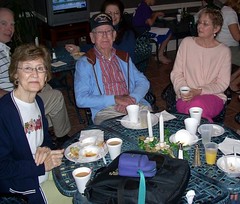
Everyone was sad to see him go, because Bob may require kidney dialysis soon. If so, it will restrict his availability for another reunion. After we said our goodbyes, we loaded everyone into the Death Van for a trip to the Tennesse Museum of Aviation. It has a nice collection of WWII aircraft, including this magnificent P-51 Mustang, the fighter that Co-Pilot Hank B* trained to fly:
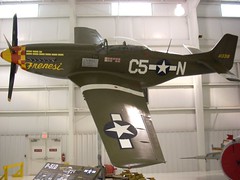
Here’s a cool TBM Avenger torpedo bomber, which was equipped with folding wings so it could be carried on aircraft carriers. It carried a crew of three, including a pilot, a radio operator (who also doubled as a gunner, firing a downward-facing gun mounted under the tail) and a turret gunner, who fired an upward-facing gun mounted in an electrically operated turret behind the cockpit:

And this is an airworthy P-47D Thunderbolt, the largest single-engine fighter aircraft produced for WWII.
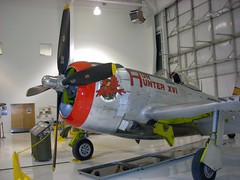
You’ll notice large oil drip pans under the aircraft. My father told me that oil leakage was a characteristic of all radial engines used during WWII. Before every takeoff in the B-29, the ground crew was required to manually rotate the propeller blades through four complete revolutions, ensuring that adequate oil was lifted into the cylinders.
They had some more contemporary aircraft as well, including this F-86 Saberjet, and a Soviet MIG-17:
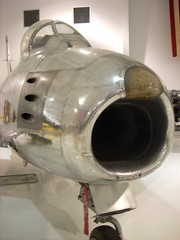
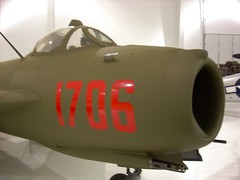
One interesting display consisted of two components of the famous top secret Norden bombsight, which my father used during the war. This bombsight was carried to the bombers under armed guard and installed just prior to each mission, then removed to a secure bunker afterwards. If an aircraft was forced to ditch or land in enemy territory, bombardiers were under strict instructions to destroy the bombsight by emptying a clip from their .45 caliber sidearm into it.
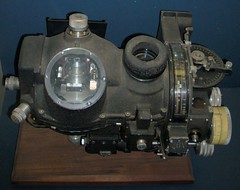
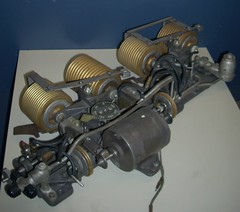
In the gift shop, my brother-in-law was browsing through the book section, and found a book called "Nose Art." It contained images culled from the national archives and private collections of the girlie pictures found on military aircraft.
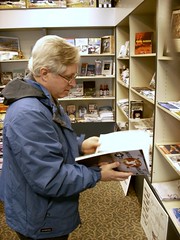
And on page 190, he found my father’s aircraft. It was a huge surprise, and he bought the book for my dad. This almost makes up for his poor navigation on the drive out to Tennessee.
After the museum, we had lunch in a country-style restaurant built around an old farmhouse located in an apple orchard. They serve a basket of delicious apple fritters with every meal. In my opinion, these things should be illegal:
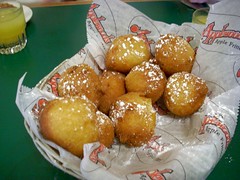
Later, the ladies wandered through the gift shops, while the crew hung out swapping stories and jokes in the orchard, which was just starting to bud out with the promise of a new crop.
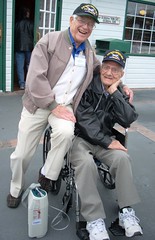


Everyone was sad to see him go, because Bob may require kidney dialysis soon. If so, it will restrict his availability for another reunion. After we said our goodbyes, we loaded everyone into the Death Van for a trip to the Tennesse Museum of Aviation. It has a nice collection of WWII aircraft, including this magnificent P-51 Mustang, the fighter that Co-Pilot Hank B* trained to fly:

Here’s a cool TBM Avenger torpedo bomber, which was equipped with folding wings so it could be carried on aircraft carriers. It carried a crew of three, including a pilot, a radio operator (who also doubled as a gunner, firing a downward-facing gun mounted under the tail) and a turret gunner, who fired an upward-facing gun mounted in an electrically operated turret behind the cockpit:

And this is an airworthy P-47D Thunderbolt, the largest single-engine fighter aircraft produced for WWII.

You’ll notice large oil drip pans under the aircraft. My father told me that oil leakage was a characteristic of all radial engines used during WWII. Before every takeoff in the B-29, the ground crew was required to manually rotate the propeller blades through four complete revolutions, ensuring that adequate oil was lifted into the cylinders.
They had some more contemporary aircraft as well, including this F-86 Saberjet, and a Soviet MIG-17:


One interesting display consisted of two components of the famous top secret Norden bombsight, which my father used during the war. This bombsight was carried to the bombers under armed guard and installed just prior to each mission, then removed to a secure bunker afterwards. If an aircraft was forced to ditch or land in enemy territory, bombardiers were under strict instructions to destroy the bombsight by emptying a clip from their .45 caliber sidearm into it.


In the gift shop, my brother-in-law was browsing through the book section, and found a book called "Nose Art." It contained images culled from the national archives and private collections of the girlie pictures found on military aircraft.

And on page 190, he found my father’s aircraft. It was a huge surprise, and he bought the book for my dad. This almost makes up for his poor navigation on the drive out to Tennessee.
After the museum, we had lunch in a country-style restaurant built around an old farmhouse located in an apple orchard. They serve a basket of delicious apple fritters with every meal. In my opinion, these things should be illegal:

Later, the ladies wandered through the gift shops, while the crew hung out swapping stories and jokes in the orchard, which was just starting to bud out with the promise of a new crop.


Saturday, April 5, 2008
War Stories: Dreamboat
Every military aircraft is equipped with a device called the IFF (Identification Friend or Foe). It’s a microwave-frequency transponder that is set to return a specific code when it receives an interrogation signal. The IFF is designed to prevent military anti-aircraft units from shooting down their own aircraft. The code is changed at regular intervals so that enemy aircraft can’t disguise themselves as friendly aircraft to penetrate air defenses.
The B-29 was no exception. However, the Radio Operator Jim G* would turn off the IFF whenever the Black Magic flew over Japan. There are two reasons for this: First, by returning an unknown code, the aircraft would instantly identify itself as an enemy. If it returned no code, the Japanese might invest a few precious minutes attempting a visual confirmation before opening fire. Second, even though the code pulse is very short, it is directional. An aircraft returning a code in response to an interrogation signal could theoretically be triangulated, revealing its position, course, airspeed and altitude to enemy gunners.
During one mission, Jim G* followed his normal procedure, turning off the IFF. Unfortunately, he forgot to turn it back on for the return trip. The B-29 was flying over the Pacific Ocean, which at that time was full of American warships.
One of those ships was an American submarine, running on the surface. This is back in the days before atomic power, when submarines ran on diesel engines whenever possible to conserve battery power. Submarines traveling on the surface are very vulnerable to air attacks, so the deck guns were always manned, and sailors with binoculars scanned the skies from the conning tower. One of them spotted the Black Magic and reported it to their Radio Operator, who in turn “pinged” the aircraft to identify itself.
It’s easy to imagine some nervous 19-year old sailor behind one of those deck guns, watching nervously as a large, powerful, heavily armed aircraft approaches them from the horizon. To their credit, they didn’t open fire. Instead, the radio operator broadcast the following message: “Dreamboat, dreamboat, dreamboat. Let your cockerel crow.”
When Jim G* received that message, he knew instantly what they wanted, and switched on the IFF device, probably saving their lives.
When I first heard this story from Jim G*, I suspected that the Navy Radio Operator had a poetic nature. But I did a little research, and “cockerel” is British Navy slang for an IFF device. How an American submarine crewman acquired this terminology is a mystery. As for the expression “dreamboat,” I’ve found some references that suggest that the term refers to a B-29 that has been forced to ditch at sea, so perhaps it was a veiled threat. In those day, you took threats pretty seriously.
The B-29 was no exception. However, the Radio Operator Jim G* would turn off the IFF whenever the Black Magic flew over Japan. There are two reasons for this: First, by returning an unknown code, the aircraft would instantly identify itself as an enemy. If it returned no code, the Japanese might invest a few precious minutes attempting a visual confirmation before opening fire. Second, even though the code pulse is very short, it is directional. An aircraft returning a code in response to an interrogation signal could theoretically be triangulated, revealing its position, course, airspeed and altitude to enemy gunners.
During one mission, Jim G* followed his normal procedure, turning off the IFF. Unfortunately, he forgot to turn it back on for the return trip. The B-29 was flying over the Pacific Ocean, which at that time was full of American warships.
One of those ships was an American submarine, running on the surface. This is back in the days before atomic power, when submarines ran on diesel engines whenever possible to conserve battery power. Submarines traveling on the surface are very vulnerable to air attacks, so the deck guns were always manned, and sailors with binoculars scanned the skies from the conning tower. One of them spotted the Black Magic and reported it to their Radio Operator, who in turn “pinged” the aircraft to identify itself.
It’s easy to imagine some nervous 19-year old sailor behind one of those deck guns, watching nervously as a large, powerful, heavily armed aircraft approaches them from the horizon. To their credit, they didn’t open fire. Instead, the radio operator broadcast the following message: “Dreamboat, dreamboat, dreamboat. Let your cockerel crow.”
When Jim G* received that message, he knew instantly what they wanted, and switched on the IFF device, probably saving their lives.
When I first heard this story from Jim G*, I suspected that the Navy Radio Operator had a poetic nature. But I did a little research, and “cockerel” is British Navy slang for an IFF device. How an American submarine crewman acquired this terminology is a mystery. As for the expression “dreamboat,” I’ve found some references that suggest that the term refers to a B-29 that has been forced to ditch at sea, so perhaps it was a veiled threat. In those day, you took threats pretty seriously.
Friday, April 4, 2008
Bicuits and Bells
On the second day of the reunion, I woke up early and drifted upstairs to lounge area in the hotel where a large buffet breakfast was laid out every morning. The crew members assembled for a nice relaxing meal and chatted. Here’s my dad, Radio Operator Jim G*, and our host, Dean B* with his wife Betty. They’re looking at a file folder my father brought with him, stuffed with old photos and memorabilia.
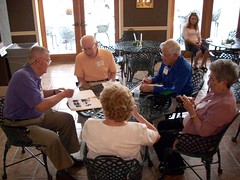
Meanwhile, I fortified myself with eggs, sausage, orange juice, coffee, and that peculiar Southern breakfast item, biscuits and gravy. They eat a lot of biscuits in Tennessee. It seemed as though they were served at every meal. Because they’re dry, people use them to “sop” soup or gravy. At one lunch, Radar Operator Dean ordered a ham steak, which of course was served with biscuits and something called “Red Eye Gravy.” It’s a thin sauce made from ham grease, coffee and paprika. Dean asked if I wanted to try it, instructing me to pour it over a biscuit. It’s unusual to my taste, bordering on weird.
After breakfast, Dean’s son arrived with a monstrous 15-passenger van, and there was about a half an hour confusion and discussion about how to load all these elderly men and their elderly wives into it. Eventually, the seating arrangements were worked out, and I rode in the seat furthest from the front. It involved clambering sideways over a wheel well and a spare tire. It was cramped and uncomfortable, and all I could think about during the drive along those twisty mountain roads was that if there was an accident, they’d have to cut me out with acetylene blowtorches.
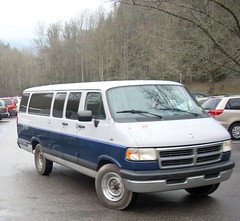
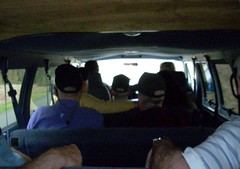
We drove to the Great Smoky Mountains National Park museum. While we were there, a white-haired guy came up and introduced himself as Earl W*, a WWII B-24 pilot. There was an instant camaraderie between the men, who shared a conversation that ranged from technical details about the aircraft to the painful losses they had experienced. He posed for photos with the men, then said his goodbyes. Here’s the group (Left to Right: Radio Operator Jim G*, my dad, Tail Gunner Bob M* (behind the wheelchair), Co-Pilot Hank B* in the wheelchair, Radar Operator Dean B*, Earl W*, and Joe S*.
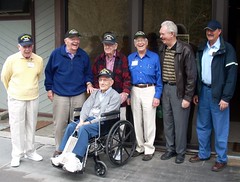
I was surprised how often people would come up to the crew to say hello, and often express their thanks for the service of these men. They were like celebrities, and they loved every minute of it.
After the museum, we drove to Dean’s family cabin, which is located a short distance from the park on a branch of the Little Pigeon river. We were surprised when, just outside the park gates, a police car pulled in front of us with its lights on and escorted us to the cabin. The officer pulled over at the driveway and saluted the vehicle as we pulled in. It was a surprise, and a good one.
Dean’s daughter Ruth and her husband live in the cabin, and it’s a beautiful spot.


Dean welcomed everyone, and we had a huge barbecue lunch. Ruth’s father-in-law brought a flying model of a B-29 with a 7-foot wingspan that he had made years ago (it no longer flies).
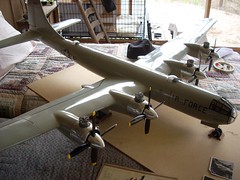
After lunch Ruth performed with her old-time Appalachian band, called “Boogertown Gap.” There’s an actual place called Boogertown in the hills of Tennessee. I have to wonder what they call their High School football team.
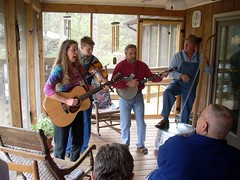
Dean is a soft-spoken Tennessee gentleman, with a gracious charm. He plays tennis, despite a hip injury that forces him to walk with a limp. And he’s active in his church, playing something called “hand bells” with his daughter Jan at church functions (I guess you can tell I don’t get out to church much). I asked him how long he had lived in this area, and he answered with a twinkle, “85 years.”
He’s the kind of guy who probably could have gone anywhere and done anything he wanted, but he wanted to stay in the Appalachians. And the Appalachians are all the better for it.
After lunch, Dean asked if anyone would like to take a short walk. My dad and my brother-in-law Lee declined, preferring to relax by the river:
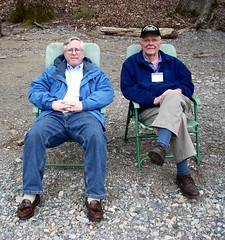
Dean grabbed a cane, and led us up a dangerously steep little path along the side of a hill. One misstep, and you’d tumble 40 feet down into the river. The cherry trees were in bloom as we walked, passing an old cemetery and a covered bridge. Dean hobbled along like a mountain goat, outdistancing us all. It must be all those biscuits he eats.
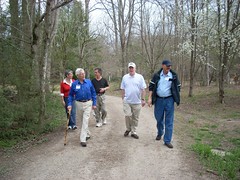
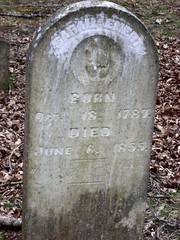
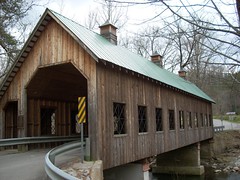
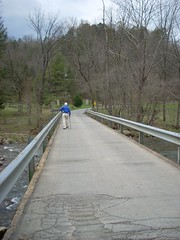

Meanwhile, I fortified myself with eggs, sausage, orange juice, coffee, and that peculiar Southern breakfast item, biscuits and gravy. They eat a lot of biscuits in Tennessee. It seemed as though they were served at every meal. Because they’re dry, people use them to “sop” soup or gravy. At one lunch, Radar Operator Dean ordered a ham steak, which of course was served with biscuits and something called “Red Eye Gravy.” It’s a thin sauce made from ham grease, coffee and paprika. Dean asked if I wanted to try it, instructing me to pour it over a biscuit. It’s unusual to my taste, bordering on weird.
After breakfast, Dean’s son arrived with a monstrous 15-passenger van, and there was about a half an hour confusion and discussion about how to load all these elderly men and their elderly wives into it. Eventually, the seating arrangements were worked out, and I rode in the seat furthest from the front. It involved clambering sideways over a wheel well and a spare tire. It was cramped and uncomfortable, and all I could think about during the drive along those twisty mountain roads was that if there was an accident, they’d have to cut me out with acetylene blowtorches.


We drove to the Great Smoky Mountains National Park museum. While we were there, a white-haired guy came up and introduced himself as Earl W*, a WWII B-24 pilot. There was an instant camaraderie between the men, who shared a conversation that ranged from technical details about the aircraft to the painful losses they had experienced. He posed for photos with the men, then said his goodbyes. Here’s the group (Left to Right: Radio Operator Jim G*, my dad, Tail Gunner Bob M* (behind the wheelchair), Co-Pilot Hank B* in the wheelchair, Radar Operator Dean B*, Earl W*, and Joe S*.

I was surprised how often people would come up to the crew to say hello, and often express their thanks for the service of these men. They were like celebrities, and they loved every minute of it.
After the museum, we drove to Dean’s family cabin, which is located a short distance from the park on a branch of the Little Pigeon river. We were surprised when, just outside the park gates, a police car pulled in front of us with its lights on and escorted us to the cabin. The officer pulled over at the driveway and saluted the vehicle as we pulled in. It was a surprise, and a good one.
Dean’s daughter Ruth and her husband live in the cabin, and it’s a beautiful spot.


Dean welcomed everyone, and we had a huge barbecue lunch. Ruth’s father-in-law brought a flying model of a B-29 with a 7-foot wingspan that he had made years ago (it no longer flies).

After lunch Ruth performed with her old-time Appalachian band, called “Boogertown Gap.” There’s an actual place called Boogertown in the hills of Tennessee. I have to wonder what they call their High School football team.

Dean is a soft-spoken Tennessee gentleman, with a gracious charm. He plays tennis, despite a hip injury that forces him to walk with a limp. And he’s active in his church, playing something called “hand bells” with his daughter Jan at church functions (I guess you can tell I don’t get out to church much). I asked him how long he had lived in this area, and he answered with a twinkle, “85 years.”
He’s the kind of guy who probably could have gone anywhere and done anything he wanted, but he wanted to stay in the Appalachians. And the Appalachians are all the better for it.
After lunch, Dean asked if anyone would like to take a short walk. My dad and my brother-in-law Lee declined, preferring to relax by the river:

Dean grabbed a cane, and led us up a dangerously steep little path along the side of a hill. One misstep, and you’d tumble 40 feet down into the river. The cherry trees were in bloom as we walked, passing an old cemetery and a covered bridge. Dean hobbled along like a mountain goat, outdistancing us all. It must be all those biscuits he eats.




Thursday, April 3, 2008
Superfortress
At the start of World War II, the United States had only developed medium-range bombers, which were primitive by today’s standards. For one thing, they were unpressurized, which meant that above 14,000 feet, the crew members required oxygen masks. Worse, the interior temperature of the aircraft plummeted as low as 65 degrees below zero at high altitudes, forcing the crew to wear heavy leather flight suits lined with sheepskin. As Co-Pilot Hank B* said, “You had to wear gloves to fly the plane, because if you touched anything with your bare hands, the skin would peel off.”
The crew’s defensive capability was limited by the skill of its gunners, who fired independently at targets of their own choosing. The most notable examples of these bombers were the B-17 and B-24, which were primarily deployed in Europe, where they were subject to ruthless flak and fighter attacks. Thousands of them were lost.
The B-29 Superfortress, which was only deployed in the Pacific theater, was a revolutionary advance in bomber design. First of all, it was the first aircraft in the world to have completely pressurized crew compartments (the bomb bay was not pressurized), which were also heated. My father described it as a “shirtsleeve environment.”
The range of the B-29 (3,250 miles) far outdistanced its predecessors, the B-17 Flying Fortress (2,000 miles) and the B-24 Liberator (2,100 miles). More significantly, the B-29 could carry a staggering 20,000 pounds of bombs, four times the capacity of the B-24 and 10 times the capacity of the B-17.
In addition, a new gunnery system was developed for the B-29. The Chief Gunner didn’t actually fire a weapon. Instead, he operated a sighting device that used newly-developed on-board “electric computers” to calculate the aiming points for the ship’s guns, which were aimed and fired by remote control. The only exception was the tail gun, which was fired manually by the Tail Gunner. At any point, any other crew members could assume manual control of one of the remote-controlled gunning stations, if necessary.
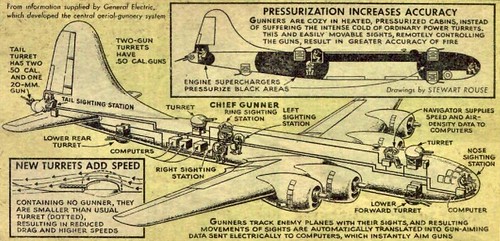
When my father completed his bombardier training, he was assigned to a crew, and departed from Alamagordo, New Mexico in a brand-new, shiny B-29. However, once they arrived in Guam, they were ferried by boat to Saipan, and assigned one of the oldest B-29s on the base. They expressed some disgust over this “bait-and-switch” tactic, but soon discovered that their ground crew was run by Master Sergeant Chester Moody, a seasoned veteran who took great pride in his work, and ensured that every glitch in the Black Magic was fixed quickly and correctly. Rather than petition the base commander for a newer aircraft, the crew stuck with Black Magic and Sergeant Moody.
My father told me that missions typically lasted around 16 hours. The Japanese were warned ahead of time by aircraft dropping leaflets that certain cities had been targeted for bombing raids, but the leaflets didn’t say exactly which city would be bombed, or when. This was to enable the Japanese to take steps to protect their civilian population.
The Black Magic would fly from the island of Saipan in the Mariana Islands (over a thousand miles south of Japan) to the northernmost of the Japanese islands, complete a bombing raid and have just enough fuel to return to Saipan. Once the island of Iwo Jima was captured, damaged or fuel-starved aircraft could find a friendly airstrip that was about 500 miles closer to Saipan.
According to my father, the most detested duty was nighttime “Pathfinder” flights. A solitary bomber would be sent over the target area with no bomb load, while the rest of the squadron waited in a holding pattern offshore. They would fly a figure-8 pattern directly over the target, at low altitude and in full view of the enemy spotlights. The cabin would be depressurized, and a crew member would drop spools of what they called “rope” – actually rolls of aluminum foil - through the camera bay door. These spools would unwind as they fell, drifting through the enemy radar to produce false echoes. Then the squadron of loaded bombers would fly in and drop their bombs, invisible to the enemy radar. But of course, the Pathfinder aircraft was a sitting duck until the mission ended. Thank goodness Pathfinder missions were handed out in rotation so nobody had to do it more than once or twice.
The crew’s defensive capability was limited by the skill of its gunners, who fired independently at targets of their own choosing. The most notable examples of these bombers were the B-17 and B-24, which were primarily deployed in Europe, where they were subject to ruthless flak and fighter attacks. Thousands of them were lost.
The B-29 Superfortress, which was only deployed in the Pacific theater, was a revolutionary advance in bomber design. First of all, it was the first aircraft in the world to have completely pressurized crew compartments (the bomb bay was not pressurized), which were also heated. My father described it as a “shirtsleeve environment.”
The range of the B-29 (3,250 miles) far outdistanced its predecessors, the B-17 Flying Fortress (2,000 miles) and the B-24 Liberator (2,100 miles). More significantly, the B-29 could carry a staggering 20,000 pounds of bombs, four times the capacity of the B-24 and 10 times the capacity of the B-17.
In addition, a new gunnery system was developed for the B-29. The Chief Gunner didn’t actually fire a weapon. Instead, he operated a sighting device that used newly-developed on-board “electric computers” to calculate the aiming points for the ship’s guns, which were aimed and fired by remote control. The only exception was the tail gun, which was fired manually by the Tail Gunner. At any point, any other crew members could assume manual control of one of the remote-controlled gunning stations, if necessary.

When my father completed his bombardier training, he was assigned to a crew, and departed from Alamagordo, New Mexico in a brand-new, shiny B-29. However, once they arrived in Guam, they were ferried by boat to Saipan, and assigned one of the oldest B-29s on the base. They expressed some disgust over this “bait-and-switch” tactic, but soon discovered that their ground crew was run by Master Sergeant Chester Moody, a seasoned veteran who took great pride in his work, and ensured that every glitch in the Black Magic was fixed quickly and correctly. Rather than petition the base commander for a newer aircraft, the crew stuck with Black Magic and Sergeant Moody.
My father told me that missions typically lasted around 16 hours. The Japanese were warned ahead of time by aircraft dropping leaflets that certain cities had been targeted for bombing raids, but the leaflets didn’t say exactly which city would be bombed, or when. This was to enable the Japanese to take steps to protect their civilian population.
The Black Magic would fly from the island of Saipan in the Mariana Islands (over a thousand miles south of Japan) to the northernmost of the Japanese islands, complete a bombing raid and have just enough fuel to return to Saipan. Once the island of Iwo Jima was captured, damaged or fuel-starved aircraft could find a friendly airstrip that was about 500 miles closer to Saipan.
According to my father, the most detested duty was nighttime “Pathfinder” flights. A solitary bomber would be sent over the target area with no bomb load, while the rest of the squadron waited in a holding pattern offshore. They would fly a figure-8 pattern directly over the target, at low altitude and in full view of the enemy spotlights. The cabin would be depressurized, and a crew member would drop spools of what they called “rope” – actually rolls of aluminum foil - through the camera bay door. These spools would unwind as they fell, drifting through the enemy radar to produce false echoes. Then the squadron of loaded bombers would fly in and drop their bombs, invisible to the enemy radar. But of course, the Pathfinder aircraft was a sitting duck until the mission ended. Thank goodness Pathfinder missions were handed out in rotation so nobody had to do it more than once or twice.
Wednesday, April 2, 2008
Meet the Crew
My father’s WWII bomber crew reunion took place in eastern Tennessee, in a town called Sevierville (the birthplace of Dolly Parton), which is just north of Pigeon Forge and Gatlinburg. It’s nestled in the Great Smoky Mountains, but if you think it’s quaint and picturesque, you’d be wrong.
I suppose at some point in the past it was a bucolic little farming community, but thanks to Dollywood, it’s now a giant traffic jam of restaurants, motels, musical theaters and souvenir stands. We had plenty of time to suffer through it, because my brother-in-law, who had been appointed Navigator and Trash Officer for the trip, had directions to the wrong hotel.
We were the last to arrive, and found the crew in the parking lot of the hotel, getting ready to leave for dinner. Here’s my dad and Tail Gunner Bob O*, who occupied opposite ends of the B-29 during the war:
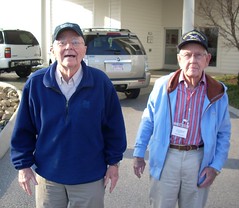
And here’s my dad and Co-Pilot Hank B*, who were roommates in the officer’s quarters on the island of Saipan:
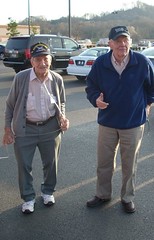
I won’t name the major chain restaurant we visited, but if you think we received prompt, professional service, you’d be wrong. My father’s meal didn’t arrive until everyone else had finished. The orders were wrong, the checks were wrong, the wait staff was struggling. And this was on Wednesday, an otherwise slow night. But if you think anyone in my father’s bomber crew cared about the crappy service, you’d be wrong.
They hadn’t seen each other for 4 years, but they gabbed like magpies the whole time, enjoying the charge of reliving their glory days. Here’s the whole crew (left to right: Radio Operator Jim G*, my dad, Tail Gunner Bob O*, Co-Pilot Hank B*, and our host, Radar Operator Dean B*):
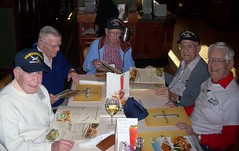
Here’s Radio Operator Jim G* and my dad, enjoying a few laughs:
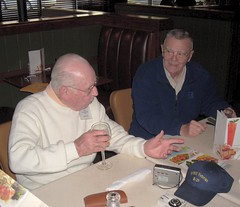
Here’s Tail Gunner Bob O* and Co-Pilot Hank B*.

At 92, Hank is the oldest crew member. He has to carry an oxygen tank around, but if you think he’s falling apart, you’d be wrong. His daughter told me he has 20/15 vision, which has degraded from the 20/5 he had during his flying years. Hank trained to fly the P-51 Mustang fighter, the performance sports car of the aviation world at the time. But when it came time for combat assignments, he was turned down because he was 2 pounds heavier than the maximum allowable weight. If you think he’s still upset about it, you’d be right.
Hank showed up with the largest entourage, consisting of his three kids and their families. They were a terrific bunch of people, enjoying the party as much as the crew.
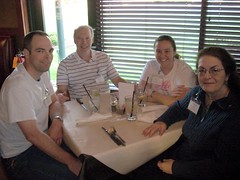

All of the crew showed up with family members, but there was one exception. Ed S*, the Chief Gunner of the Black Magic, had passed away in the sixties. Here he is, on the right, in front of the Black Magic:

His son Joe followed in his footsteps, becoming an Air Force officer. He eventually retired from the Air Force while working in the Pentagon, and now holds the same job as a civilian in the Department of Defense. Joe showed up at the first Black Magic reunion in his father’s place, and he came to this one as well.

He’s a cheerful, funny guy, but he can’t talk about his military history or his current job. If you try to guess what he does for a living, you might be right, but keep an eye out for unmarked cars on the way home.
I suppose at some point in the past it was a bucolic little farming community, but thanks to Dollywood, it’s now a giant traffic jam of restaurants, motels, musical theaters and souvenir stands. We had plenty of time to suffer through it, because my brother-in-law, who had been appointed Navigator and Trash Officer for the trip, had directions to the wrong hotel.
We were the last to arrive, and found the crew in the parking lot of the hotel, getting ready to leave for dinner. Here’s my dad and Tail Gunner Bob O*, who occupied opposite ends of the B-29 during the war:

And here’s my dad and Co-Pilot Hank B*, who were roommates in the officer’s quarters on the island of Saipan:

I won’t name the major chain restaurant we visited, but if you think we received prompt, professional service, you’d be wrong. My father’s meal didn’t arrive until everyone else had finished. The orders were wrong, the checks were wrong, the wait staff was struggling. And this was on Wednesday, an otherwise slow night. But if you think anyone in my father’s bomber crew cared about the crappy service, you’d be wrong.
They hadn’t seen each other for 4 years, but they gabbed like magpies the whole time, enjoying the charge of reliving their glory days. Here’s the whole crew (left to right: Radio Operator Jim G*, my dad, Tail Gunner Bob O*, Co-Pilot Hank B*, and our host, Radar Operator Dean B*):

Here’s Radio Operator Jim G* and my dad, enjoying a few laughs:

Here’s Tail Gunner Bob O* and Co-Pilot Hank B*.

At 92, Hank is the oldest crew member. He has to carry an oxygen tank around, but if you think he’s falling apart, you’d be wrong. His daughter told me he has 20/15 vision, which has degraded from the 20/5 he had during his flying years. Hank trained to fly the P-51 Mustang fighter, the performance sports car of the aviation world at the time. But when it came time for combat assignments, he was turned down because he was 2 pounds heavier than the maximum allowable weight. If you think he’s still upset about it, you’d be right.
Hank showed up with the largest entourage, consisting of his three kids and their families. They were a terrific bunch of people, enjoying the party as much as the crew.


All of the crew showed up with family members, but there was one exception. Ed S*, the Chief Gunner of the Black Magic, had passed away in the sixties. Here he is, on the right, in front of the Black Magic:

His son Joe followed in his footsteps, becoming an Air Force officer. He eventually retired from the Air Force while working in the Pentagon, and now holds the same job as a civilian in the Department of Defense. Joe showed up at the first Black Magic reunion in his father’s place, and he came to this one as well.

He’s a cheerful, funny guy, but he can’t talk about his military history or his current job. If you try to guess what he does for a living, you might be right, but keep an eye out for unmarked cars on the way home.
Subscribe to:
Posts (Atom)
